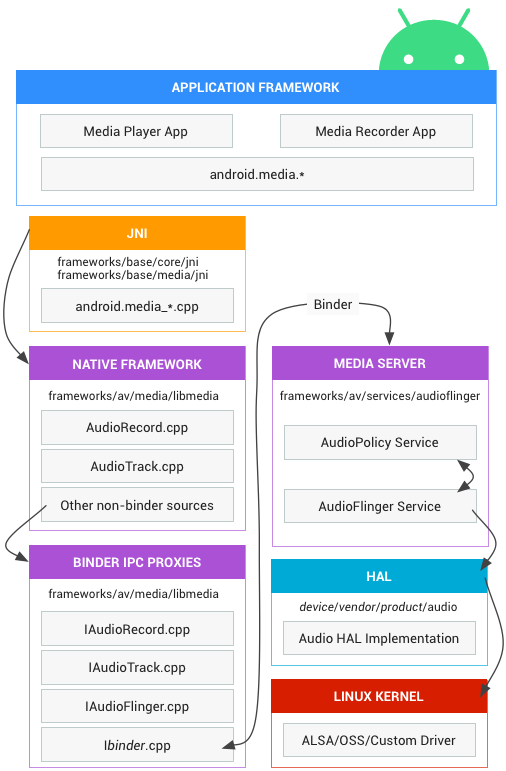IN THIS DOCUMENT
Android's audio Hardware Abstraction Layer (HAL) connects the higher-level, audio-specific framework APIs in android.media to the underlying audio driver and hardware. This section includes implementation instructions and tips for improving performance.

Audio Architecture
The following figure and list describe how audio functionality is implemented and the relevant source code that is involved in the implementation:

Figure 1. Android audio architecture
Application frameworkAt the application framework level is the app code, which utilizes the android.media APIs to interact with the audio hardware. Internally, this code calls corresponding JNI glue classes to access the native code that interacts with the audio hardware.
JNI
The JNI code associated with android.media is located in the frameworks/base/core/jni/ andframeworks/base/media/jni directories. This code calls the lower level native code to obtain access to the audio hardware.
Native framework
The native framework is defined in frameworks/av/media/libmedia and provides a native equivalent to theandroid.media package. The native framework calls the Binder IPC proxies to obtain access to audio-specific services of the media server.
Binder IPC
The Binder IPC proxies facilitate communication over process boundaries. They are located in theframeworks/av/media/libmedia directory and begin with the letter "I".
Media Server
The audio services in the media server, located in frameworks/av/services/audioflinger, is the actual code that interacts with your HAL implementations.
HAL
The HAL defines the standard interface that audio services call into and that you must implement to have your audio hardware function correctly. The audio HAL interfaces are located inhardware/libhardware/include/hardware. See
Kernel Driver
The audio driver interacts with the hardware and your implementation of the HAL. You can choose to use ALSA, OSS, or a custom driver of your own at this level. The HAL is driver-agnostic.
Note: If you do choose ALSA, we recommend using external/tinyalsa for the user portion of the driver because of its compatible licensing (The standard user-mode library is GPL licensed).
Not shown: Android native audio based on OpenSL ES. This API is exposed as part of Android NDK, and is at the same architecture level as android.media.
